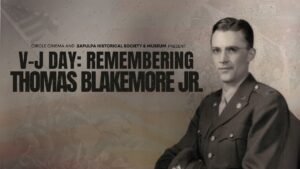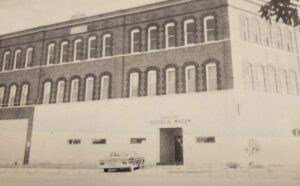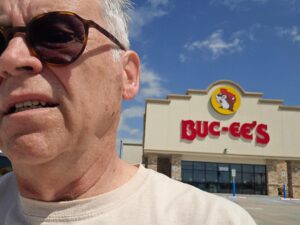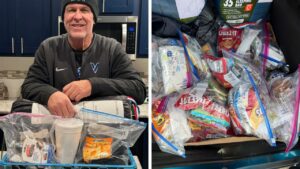By Cecil Cloud
This story has it all—oil men, financiers, Indians, railroad speculators, big deals, burning creeks, bank failures, Machine Gun Kelly, G-Men, Zingo—and Route 66.
No, it’s not The Great Trolley Conspiracy from “Who Framed Roger Rabbit?” It’s the story of the Sapulpa & Interurban Railway and it happened here, on the streets of that great city, Sapulpa, Oklahoma.
The Trolley Car was high-tech in 1905. Derived from the horse cars used in eastern cities before the Civil War, electric trolleys appeared in the 1890s.
Electric cars used lighter track and bridges than steam locomotives. Trolley companies could sell electric power to consumers and use it to power amusement parks. The low start-up costs compared to steam railroads made trolley lines a popular investment at the start of the Twentieth Century.
Sapulpa was a forward-looking town. The first local trolley line, the Sapulpa & Interurban Railway Company, was chartered in July of 1907 by Ed C. Reynolds. The original plan was to build a line to Kiefer and points beyond. In 1908 the line was operating between Sapulpa and Glenpool. It reached Mounds by the end of 1908. In 1909 H.E. Clark was serving as an executive of the company. In that year, the Sapulpa and Interurban made its first run down the Fife Place line to Hastain and on to the steel mill (now Kelley Lane Park). 1910 saw the construction of the downtown loop: starting from Main and Dewey, east on Dewey to Park, north on Park to Hobson, then west to Main and south on Main back to Dewey. The line from Main and Lee south to a connection with the interurban line to Kiefer was built in this year. In May of 1910, Ed Reynolds was promoting a plan to connect the Sapulpa and Interurban to Joplin and Shawnee. This was one of many “paper railroad” schemes that never developed.
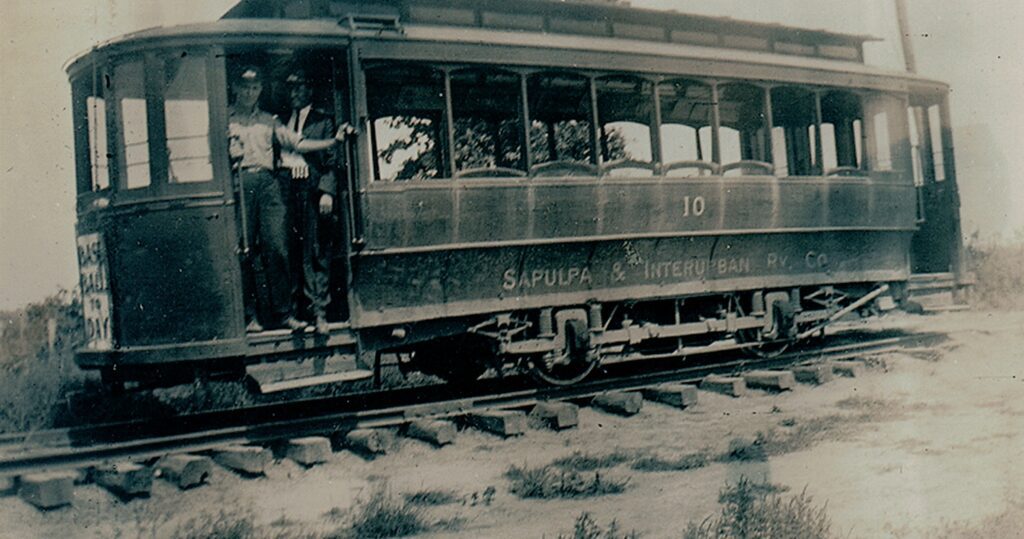
The Interurban line to Kiefer left the car shops, crossed Main to a bridge over Rock Creek, followed the line of Glenpool Street to the Steel Mill (Kelley Lane Park) site, crossed Rock Creek again and headed southeast, roughly parallel to the Frisco tracks. The Interurban crossed the Frisco tracks at a point east of Rock Creek and south of what is now Tanglewood II Addition. It then crossed Polecat Creek on a reinforced concrete bridge similar to the familiar bridge over Nickel Creek between Sapulpa and Tulsa. The line then diverged from the Frisco, entering Kiefer from the north.
Directors of the Sapulpa and Interurban in 1911 were Reynolds, President R.B. Burnett, and Treasurer B.C. Burnett. J.P. Soliss was Vice President and R.V. Miller was General Manager, a position he held through many years and reorganizations. By 1911, the Sapulpa and Interurban had partially completed a line into Glenpool.
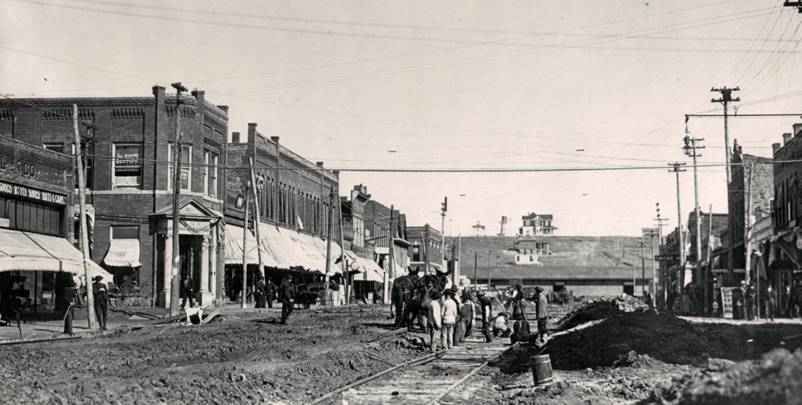
Meanwhile, the small town of Tulsa gained a trolley line: the Tulsa Traction Line was chartered in April, 1909, with A.A. Small as President and G.B. Small as Treasurer. Investors included C.L. Holland and S.A. Orcutt. Tulsa Traction had a line operating from 4th and Boulder to Orcutt Park by December, 1909. After a reorganization, this company resurfaced as the Oklahoma Union Railway, with a charter to operate from Owen Park to Orcutt Park via 4th Street in downtown Tulsa. By November of 1910, this company had completed grading from West Tulsa to Red Fork and was building on to Sapulpa, following “an old, existing grade.”
Orcutt Park was an amusement park built around a lake near the intersection of 21st and Utica in Tulsa. This site is now the Swan Lake neighborhood. Old pictures show that Orcutt Park Lake was larger than the current lake. Park attractions included a dance pavilion, natatorium, the Air Drome Theater, and a roller coaster. The centerpiece of the lake was a large concrete fountain. The park survived until 1917, when Sam Orcutt sold the site to a developer.
The Panic of 1910-11 has been called a minor recession precipitated by the Sherman Antitrust Act. That “minor recession” led to a stock market drop of about 26%. The same source says the downturn affected mainly stock speculators and financiers. It certainly affected the railroad business.
1912 was a bad year for the Burnett Brothers. The Sapulpa and Interurban went bankrupt. Their Farmers and Merchant Bank failed. Closed by the State Banking Board on September 10, its accounts were taken over by the new Oklahoma State Bank on September 20th. Ultimately, the brothers lost control of the Sapulpa and Interurban. General Manager Miller became receiver of the line in 1912. The line was reorganized as the Sapulpa Electric Interurban Railway, using that name until the merger which created the Oklahoma Union Railway. The only carryover from the old company was Mr. Miller.
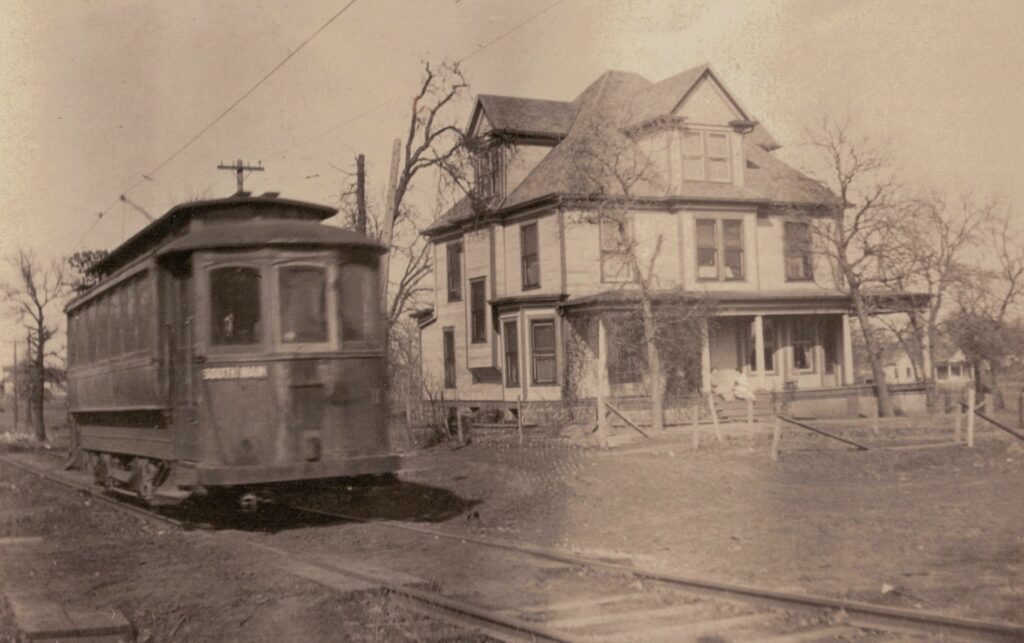
The Sapulpa Argus for Friday, December 26, 1913, ran with the headline: “Interurban will extend to Schramm this week.” The Schramm Glass Plant was just west of the city along a county road that later became Route 66. This article is the first mention of what would become the line to the city water plant on Rock Creek.
The Sunflower Glass Company was farther out along Route 66 just west of a site that would become the Teepee Drive-In. This plant made hand-blown window glass. The rails of a Frisco spur to this plant are still visible in the Portland cement of old Route 66. Plans were made to extend the Water Plant line west to Sunflower Glass and on to the Sapulpa Reservoir on Euchee Creek, but they were never implemented.
September 6, 1915, was a big day for the Oklahoma Union Traction Company in Tulsa. New owners brought a new name: Tulsa Traction. The new ownership group included Joshua A. Cosden of Cosden Oil and Earl F. Sinclair, the brother of Harry Sinclair. G.C. Stebbins was a carry-over from the original Oklahoma Union Traction owners. I.F. Crow would become an officer of the Oklahoma and Southwestern.
The Sapulpa and Interurban was bankrupt in 1916 and was to be sold at auction on August 22nd. There was speculation that the Midland Valley would buy the line. On September 22 the Midland Valley put in a bid for the interurban right-of-way from Kiefer to Glenpool.
Joshua Cosden is remembered as the first Oklahoma oil man to become one of “the New York 400.” He and the Sinclair brothers were active investors in the area. Cosden and Sinclair were also involved in the Sapulpa and Oilfields railroad, launched in 1915; the Oklahoma and Southwestern, along with Thomas B. Slick; and the Midland Valley Railroad. The interests of these lines, and the Oklahoma Union Traction Company became intertwined in the 1930s.
Oil spills were a fact of life in the early days. Oil and gas fires were common. Oil spills floating on the creeks often burned. The owners of the Interurban avoided wooden trestles, spanning creeks with reinforced concrete bridges. The grades and embankments were built to steam railroad standards.
Now a digression: On July, 27, 1916, the first Birney Safety Car went into service in Seattle, Washington. The first Birney in Sapulpa ran on March 24, 1918. More a concept than a specific make of trolley, the Birney was set up for safe and efficient operation by a one-man crew. Double truck Birneys were built for interurban service. Single truck Birneys were built for the tight curves and clearances of city lines. The trolley lines in Sapulpa, Sand Springs, and Tulsa were heavy users of Birney Cars. Sapulpa got its first Birney car on the Cobb Street line in 1918. One Sapulpa Birney car went on to a second life as Wimpy’s Diner. Another became a gas station, then a tool shed, and was ultimately restored to its original appearance. Other Tulsa and Sand Springs Birney cars were repurposed as bungalows and motel cabins.
In the ‘teens a couple of familiar names enter the Interurban story: D.C. “Coin” Harvey and Cyrus Avery. Both men were “Good Roads” advocates. Although Harvey—no relation to Fred Harvey of “Harvey House” fame—had railroad speculation in his background, he was one of the fathers of “The Ozark Trail.” Harvey was booming the Ozark Trail as early as 1916. Avery became known as “The Father of Route 66.” Their work, when it came to fruition in the late ’20s and early ’30s, would have a direct impact on the Interurban.
In 1917 the nascent Oklahoma Union went to work on the 13-mile line between Sapulpa and Tulsa. By 1918, the Oklahoma Union merger was complete and approved by the courts. The new line was operating 27.2 miles of track, operating 15 cars, and offering hourly runs between Sapulpa and Tulsa.
The Burnett Brothers were out of the Interurban line after 1912, but they continued to be active in oil and real estate development in the area. The brothers had a success in the oilfield known as the Cushing Extension. Operating as the Cushing Petroleum Company, they opened an office at #52 Broadway, New York City, in 1918. Bates was in New York City on business in February 1925 when he became ill, and died following an emergency operation.
1919 was another bad year for the trolley company. Labor trouble led to a move to abandon all city lines. The Corporation Commission denied this request. The water plant line was taken up by 1919. The turmoil of the late teens would soon be eclipsed by the ambitions of the new owners of the line.
Stay tuned for part 2!



